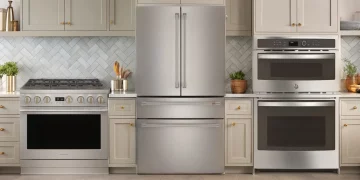Welcome to the world of smart homes, where everyday living is transformed through technology. Smart homes, once a concept of the future, are now a present-day reality, offering unparalleled convenience and efficiency. They’re about integrating technology seamlessly into our homes, making daily tasks easier and more enjoyable. In this guide, we’ll explore how to transition your home into a smart one. From understanding the basics, choosing the right devices, to ensuring security and smooth operation, we’ll cover it all. Whether you’re a tech-savvy individual or just starting out, you’ll find valuable insights and practical tips to embark on this exciting journey. Let’s begin our adventure into creating a smart, responsive, and efficient home!
Key Takeaways
Smart homes bring ease and efficiency into your life, transforming mundane tasks into automated, effortless actions.
- Think of controlling your home environment through voice commands or a smartphone app.
- The key benefits include convenience, energy savings, and enhanced security.
- In the kitchen, smart appliances simplify cooking and storage, while in the laundry room, smart washers and dryers offer time-saving features.
- It’s not just about technology; it’s about enhancing your lifestyle.
This guide will provide a roadmap to help you navigate the world of smart home technology with ease!
Step 1: Understanding Smart Home Basics
Embarking on your smart home journey begins with understanding the basics. So, what exactly is a smart home? Simply put, a smart home uses internet-connected devices that enable you to control and automate household systems and appliances. Whether it’s lighting, heating, or even your coffee maker, these devices can be managed remotely via your smartphone or voice commands.
Central Hub and Ecosystems
The heart of a smart home is the central hub or ecosystem. This can be a physical device like Amazon Echo or Google Nest, or an app on your smartphone. Think of it as the command center that connects and controls all your smart devices.
Why It Matters
This ecosystem is crucial because it ensures all your devices can communicate with each other seamlessly. For instance, if you choose an Amazon Echo, you’ll want to ensure the devices you buy are compatible with Amazon’s Alexa.
Pro Tip
When I started, I found it helpful to think about what I wanted to automate first (like lighting or heating) and choose an ecosystem that worked best with those devices.
Understanding this foundation will help you choose the right devices for your home, creating a cohesive and smoothly functioning environment.
Step 2: Choosing Smart Home Devices
Selecting the right smart home devices can feel overwhelming, but it’s about finding what best suits your lifestyle and needs. Here’s a simple guide to get you started:
1. Start with Your Needs
Think about what you want to automate or control in your home. Is it the lights, temperature, security, or entertainment systems? Your needs will guide your choices.
2. Compatibility
This is key. Ensure the devices you’re interested in work with your central hub or ecosystem. If you have an Amazon Echo, for example, look for devices that are Alexa-compatible. This ensures they can easily connect and communicate with your hub.
3. Smart Lighting
One of the easiest ways to start is with smart lighting. Brands like Philips Hue offer bulbs that you can control with your phone or voice. You can change colors, set schedules, and even create scenes for movie nights or dinner parties.
4. Smart Thermostats
Devices like the Nest Thermostat adjust your home’s temperature based on your habits and preferences, potentially saving energy and money. They’re user-friendly and can be controlled remotely.
5. Smart Security
For added security, consider smart locks and video doorbells. These devices let you monitor your home remotely and can send alerts to your phone.
6. Entertainment
A smart TV or streaming devices like Roku can transform your entertainment experience, offering voice control and access to various streaming services.
7. Easy to Use
Look for devices that are easy to set up and use. The goal is to make your life simpler, not more complicated.
Pro Tip
When I began my smart home journey, I prioritized devices that would have the most immediate impact on my daily life, like smart bulbs and a smart thermostat. It made the transition smoother and more enjoyable.
Step 3: Securing Your Smart Home
As you integrate smart devices into your home, securing them becomes crucial. Here’s a straightforward approach to ensure your smart home is safe and private:
1. Strong Wi-Fi Security
Your smart home devices connect to the internet, mostly via your Wi-Fi network. Ensure your Wi-Fi has a strong, unique password. Consider setting up a guest network for your smart devices, keeping them separate from your personal devices.
2. Regular Firmware Updates
Manufacturers often release software updates for smart devices. These updates can fix security vulnerabilities. Make it a habit to check and install these updates regularly.
3. Understanding VPNs
A VPN, or Virtual Private Network, is a service that creates a secure internet connection. Using a VPN when accessing your smart home remotely can add an extra layer of security by encrypting your internet connection, keeping your interactions private.
4. Secure Device Settings
Many smart devices come with default settings that might not prioritize your privacy. Take the time to customize these settings. For example, if your smart camera offers data encryption, enable it.
5. Physical Security
Ensure your home’s router and other networking equipment are in a secure location to prevent unauthorized physical access.
6. Professional Advice
If you’re unsure about securing your smart home, consider consulting a cybersecurity expert for advice tailored to your setup.
Pro Tip
Focus on creating strong passwords and keeping devices updated. It’s a simple yet effective way to enhance security.
Step 4: Installation and Setup
Setting up smart home devices can seem daunting, but with the right approach, it’s quite manageable. Here’s how to get your devices up and running smoothly:
1. Start Simple
If you’re new to smart homes, begin with straightforward devices like smart bulbs or plugs. These usually require minimal setup – just plug in, connect to your Wi-Fi, and follow the instructions on the accompanying app.
2. Read the Manual
This might seem obvious, but it’s crucial. Each device comes with specific installation instructions. Take the time to read through these to avoid common setup mistakes.
3. Use the Right App
Most smart home devices have a dedicated app for setup and control. Download the official app from your device manufacturer and use it for setup and customization.
4. Connecting to Your Hub
If you’re using a central hub, ensure your device is compatible, then follow the app’s instructions to link the device to your hub. This usually involves selecting the device type and entering your Wi-Fi details.
5. Placement Matters
For devices like smart cameras or sensors, consider their placement carefully for optimal performance. For example, a smart camera should have a clear view of the area you want to monitor.
6. Test and Troubleshoot
After installation, test your device to ensure it’s working correctly. If you encounter issues, most manufacturers offer troubleshooting guides in their apps or on their websites.
7. Seamless Network Connectivity
Ensure your home Wi-Fi has strong coverage in the areas where your devices are located. Consider a Wi-Fi extender if there are connectivity issues in certain parts of your home.
Pro Tip
Taking the time to test and adjust the placement of devices like smart speakers and cameras make a significant difference in their effectiveness.
Step 5: Smart Kitchen Appliances
The kitchen, often the heart of the home, can greatly benefit from smart technology. Many brands now offer innovative appliances that can transform your cooking and food storage experience. (Check out our favorite smart fridges.) Here are some notable examples from other categories:
Samsung SmartThings
Samsung’s range includes refrigerators that can suggest recipes based on what’s inside and ovens you can control with your smartphone. The integration with SmartThings app allows for seamless control and monitoring.
Monogram
Known for luxury appliances, Monogram offers features like precision cooking technology, where you can control your oven’s temperature from your phone, ensuring perfect results every time.
Bosch
Bosch’s smart appliances, including dishwashers and ovens, can be controlled via their Home Connect app, offering convenience and efficiency in meal preparation and cleanup.
LG
LG’s smart kitchen range includes fridges with InstaView technology, letting you see inside without opening the door, and ovens that can preheat remotely.
GE and Café
GE’s smart appliances, along with its Café line, provide features like voice control and personalized settings, making everyday tasks easier and more enjoyable.
Benefits
These smart appliances not only offer convenience but also help save energy. For instance, being able to see inside your fridge without opening it reduces energy waste. Smart ovens can cook more efficiently, and smart dishwashers can adjust cycles based on load size.
Step 6: Smart Laundry Solutions
Smart laundry appliances have revolutionized the way we do laundry, bringing convenience and efficiency to an entirely new level. Here’s a quick overview:
Smart Washers and Dryers: These appliances offer features like remote start, cycle monitoring, and energy efficiency. You can control them via smartphone apps, and some even respond to voice commands.
Brands to Consider:
GE: Known for reliability and innovative features like steam cycles and app connectivity.
LG: Offers a range of smart washers and dryers with user-friendly interfaces and energy-efficient technology.
Samsung: Provides advanced options like AI-powered laundry cycles and integration with other smart home devices.
Bosch: Known for compact designs, ideal for smaller spaces, without compromising on smart features. Get our recommendations for the best smart washers and dryers.
Benefits
The primary advantages of smart laundry appliances include convenience, such as receiving notifications on your smartphone when a cycle is complete, and efficiency, with machines adjusting settings based on load size. They also integrate smoothly into a smart home ecosystem, providing a seamless laundry experience.
Step 7: Integrating Smart Home Devices
Now, let’s talk about making all your smart devices play nice together. It’s like conducting an orchestra, where each instrument has its part, but together, they create a symphony. Here’s how to achieve harmony in your smart home ecosystem:
1. The Central Hub
Think of this as your maestro. Whether it’s Amazon Echo, Google Home, or another system, this hub is key to coordinating all your devices. It sends commands and ensures every gadget is in sync.
2. Compatibility Check
Just like in a musical ensemble, not every instrument fits every genre. Make sure your smart devices are compatible with your central hub. It’s all about seamless communication.
3. App Magic
Most smart devices come with their own apps, but the real magic happens when you link them through a central app or platform. This way, you can create routines and scenes. Imagine telling your hub “Goodnight” and watching as the lights dim, the thermostat adjusts, and your doors lock – all automatically.
4. Experiment and Adjust
The first try might not be perfect. Play around with settings and routines. Maybe you want your coffee maker to start brewing as soon as your morning alarm goes off. It’s all about personalizing your experience.
Personal Touch
In my journey, experimenting with different combinations and routines was the fun part. It’s amazing to see your home respond to your lifestyle so intuitively.
Step 8: Troubleshooting Common Issues
Even in the most harmonious smart homes, a few hiccups are inevitable. But don’t worry, most issues have simple fixes. Here’s how to handle some common glitches:
1. Connectivity Problems
If a device isn’t responding, check your Wi-Fi. Sometimes, it’s as simple as a router needing a reboot. Think of it as giving your Wi-Fi a quick coffee break.
2. Compatibility Hitches
Encountered a device that’s being a bit stubborn? Double-check if it’s compatible with your hub. It’s like making sure all members of a band are reading the same music sheet.
3. App Confusion
Overwhelmed with multiple apps? Consider consolidating control in one central app or using a more comprehensive smart home platform.
4. Software Updates
Keep your devices updated. It’s like keeping your gadgets in tune – essential for a smooth performance.
Pro Tip
When I faced issues, I found that most solutions were just a quick online search away. Manufacturers often have handy FAQs and troubleshooting guides on their websites.
FAQs
What are the essential devices for a beginner setting up a smart home?
For beginners, I recommend starting with smart bulbs, a smart thermostat, and a smart speaker or hub. These devices offer a simple introduction to smart home technology and demonstrate the convenience and efficiency it brings.
How do smart appliances contribute to energy savings?
Smart appliances, like thermostats and lighting, can adapt to your habits and optimize energy use. For example, a smart thermostat can learn your schedule and adjust heating and cooling to save energy when you’re not home. Smart lighting can be programmed to turn off automatically when a room is not in use.
Can smart homes enhance security?
Absolutely. Smart security devices like video doorbells, smart locks, and security cameras add layers of security. They allow remote monitoring, send alerts for unusual activity, and some can even integrate with home alarm systems.
How can I ensure my smart home devices are secure from hackers?
To protect against hacking, use strong, unique passwords for your Wi-Fi network and smart devices. Regularly update device software, as updates often include security patches. Consider using a VPN, especially when accessing your smart home remotely, as it encrypts your internet connection.
Are there any compatibility issues I should be aware of when purchasing smart home devices?
Yes, compatibility is key. Ensure that each device is compatible with your smart home ecosystem (like Amazon Alexa, Google Assistant, or Apple HomeKit). Some devices are specific to one ecosystem, so it’s important to check before purchasing.
What should I do if my smart device isn’t working properly?
First, check if the device is connected to your Wi-Fi network and is receiving power. If it’s still not working, try resetting the device. If problems persist, consult the manufacturer’s support site for specific troubleshooting tips or contact their customer service.
Can I install and manage a smart home system myself, or do I need professional help?
Many smart home devices are designed for DIY installation and come with user-friendly instructions. However, for more complex systems or if you’re not comfortable with technology, professional installation might be a better option.
How do smart kitchens and laundry appliances add convenience?
Smart kitchen appliances can automate cooking processes, suggest recipes, and even order groceries. Smart laundry appliances can optimize washing and drying cycles, send notifications when loads are complete, and some can even detect fabric types for optimal cleaning.
What is the cost range for setting up a basic smart home system?
The cost can vary widely depending on the devices and brands you choose. A basic setup with a smart hub, a few smart bulbs, and a smart thermostat can start from a few hundred dollars and go upwards depending on the number and sophistication of devices.






